South Korean Special Operations Forces
Hot spot special war
From 1968 of the year to the present, South Korea has more than twenty identified infiltrations of submarines and saboteurs into its territorial waters, who tried to conduct reconnaissance and sabotage throughout the country.
In September, the 1996 of the year, after a submarine of the Sang-O class with a displacement of 325 tonnes stranded in reefs near Kangnung, a sea route running along the east coast of Korea, stories operation to search and neutralize saboteurs. Twenty-six North Korean commandos attempted to escape persecution in the countryside. Ten thousand people took part in the operation to block, search and prosecute them. After a week-long search in a blocked area using helicopters, a long pursuit by ground groups, twenty North Korean saboteurs were destroyed. Before the threat of encirclement and captivity, they preferred to part with life on their own, thereby avoiding lengthy and exhausting interrogations. The surviving agents showed during interrogations that the main task of their activities after penetrating the territory of the Republic of Korea was the reconnaissance of coastal military airfields, radar stations and civil defense facilities.
However, not only Pyongyang has active and combat-ready special forces.
Ground special forces
History of creation
The first special forces unit of South Korea was created during the Korean War by UN supporters. It was a top-secret parachute irregular unit, designed to act deep in the rear of the North Korean troops, carry out raids, conduct sabotage, as well as gather intelligence information.
By 1958, this unit, as well as some others created during the war years, became part of the 1 10th Parachute Regiment. Then, in the 1972 year, with the help of the United States, which trained personnel as part of a program to assist the South Korean army, the first regular special forces were created. They were the 1-I and 5-I parachute brigades and three ranger battalions. Some of these units soon, along with their American teachers and colleagues, took part in the Vietnam War.
In the mid-seventies, the ranger divisions and parachute brigades were transformed into special brigades. In the future, due to the confrontation between the two Korean states, the number of special forces increased.
Composition and tasks
At present, the special operations forces of South Korea include the headquarters and command of the special war, 1, 3, 5, 7, 9, 11 and 13 brigade of special purpose, having an organizational structure identical to their American counterparts (groups of special forces ). A special-purpose brigade consists of a headquarters, a staff company, and five special-purpose battalions. The battalion, in turn, consists of several special forces companies and a support group. The minimum full-time unit in the South Korean Special Forces is an office as part of 12 people.
Brigades have a clear purpose. 1, 3 and 5-I brigades are considered strategic and are designed to act in the rear of the enemy. The 1 Brigade is deployed at Kimpo, the 3-I is located at Songham, and the 5-I is located at Inchon. The personnel of the 1 Brigade specializes in airborne withdrawal and is qualified as paratroopers. The main way to withdraw units of the 3 Brigade to the rear of the enemy is ground. Her fighters are working out the leakage across the border and the front line. The 5 Brigade specializes in the maritime method of withdrawing groups to the rear of the enemy. The remaining four brigades are considered tactical and have the task of supporting ordinary army units, they are also used in case the enemy seizes part of the country’s territory, and they have the task of organizing a partisan war behind enemy lines.
Prepare
Brigades are recruited as recruits and volunteers. The personnel of the South Korean special forces are still working closely with their American colleagues, conducting joint training and exercises. The units have full-time American instructors from the US special-purpose groups.
Preparation is carried out according to a special program in a very rigid form.
At the special war school, which is located near Seoul, the personnel are trained in the program of long parachute jumps, as well as studying light diving training and other programs. Ranger training is also carried out at this school and at the South Korean Infantry School. Each infantry division has a reconnaissance battalion, whose personnel also undergo airborne training and training for the rangers program.
Marine Special Forces
Marine Corps
For years, the main striking force of the Marine Special Forces of the Republic of Korea is the Marine Corps, the second largest in the world after the United States Marine Corps. The Americans have made significant efforts to create, train, arm and equip them in order to have a reliable ally in this region. The first units of the Marine Corps of South Korea were created in 1949 on the eve of the Korean War, and then the number barely had two battalions. During the war, the 1 th Marine Regiment was formed on their base, which was later reorganized into a brigade. The 2 Brigade of the Blue Dragons took part in the Vietnam War from October 1965 to February 1972. Starting from the 1950 year and until the Vietnam War, and in the following years, the marines of South Korea were a real force capable of delivering a crushing blow from the sea to North Korea.
Currently, about 25 thousand people serve in the Marine Corps of the Republic of Korea. There are three divisions in the Marine Corps: 1, 2 and 6. All of them have a reputation for formations with a good level of combat training, weapons and equipment, and are able to land on the intended bridgehead and crush the enemy with their firepower. Combat training classes are known as one of the toughest in the world and as close as possible to the combat situation, therefore, the press repeatedly reported reports of the death of personnel during these trainings. In addition to divisions, the corps includes an amphibious reconnaissance battalion, the entire personnel of which has light diving training and is capable of striking deep in the rear of the enemy. The first division of the Marine Corps remains the cornerstone of the whole corps and therefore has a force reconnaissance battalion, which, according to the tasks, is divided into two main elements. The first element is two amphibious reconnaissance companies, whose task is to land on the intended bridgehead, to capture and hold it until the main forces of the amphibious landing force approach and land. The second element is two special reconnaissance companies that specialize in raids on enemy targets, sabotage, and are also trained in the fight against insurgents and partisans. The force intelligence units are fully staffed with volunteers and are intended for especially secret actions along the line of demarcation, as well as to large-scale landing operations that may occur on the peninsula.
The 2 and 6 divisions are each included in one reconnaissance.
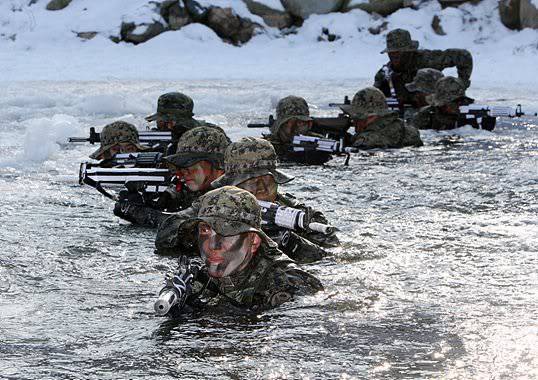
Korean "seals"
Like other special forces in South Korea, special forces fleet was created by the Americans during the war in Korea. Sabotage units were formed under the auspices of the CIA's leading organization JACK. Our magazine wrote about this in the first issues of this year.
Currently, in the fleet of South Korea, the forces of waging a special war on the sea are represented by three SEAL teams of the South Korean Navy. Each team consists of several groups of platoon personnel, and the group, in turn, consists of a commander, deputy commander, radio operator and several operators.
The first and second teams are faced with the usual tasks for such units: collecting intelligence information in the enemy’s rear, performing special tasks by conducting raids in the enemy’s rear, carrying out hidden penetration into the enemy’s territory and conducting coastal reconnaissance, and preparing for landing. amphibious assault.
The third team solves other problems. It is a national unit for combating terrorism and freeing hostages at sea.
Just as it happens in the Marine Corps and in the US Navy, only volunteers who provide exemplary service records are selected as candidates for special forces. As a result of the grueling tests during several weeks in the training camp, only those who stood the test and showed the ability to perform the assigned tasks at the limit of human capabilities were selected from these guys. After selection, a course of intensive training is scheduled for a year. During this time, very good soldiers turn into super soldiers, capable of fighting against fanatical commandos and special operations carried out by their northern neighbor.
South Korean Navy special units operate in close cooperation with their American counterparts. A constant exchange of experience between Koreans and Americans occurs both between similar units of the Marine Corps and between teams of SEALs.
Application
24 June 1998, the North Korean super-small submarine of the Yugo class with a displacement of 70 tons and with a crew of six people caught in the fishing nets. Such boats are used by North Korean naval sailors to carry out reconnaissance and sabotage operations against the Republic of Korea.
In order to raise the submarine and extract the crew and passengers from there, it was decided to tow it to the Donhgae naval base, which is located on the eastern coast of the peninsula. The moderate excitement and sea currents encountered on the way made this task difficult, therefore the boat was raised in the port only two days later.
Officials of the South Korean Defense Ministry and special forces units called to carry out the opening of the boat, understood that the crew and passengers of the boat were either dead or hid on board and were waiting for a chance to escape outside using the existing on board weapons. Not wanting to leave the enemy a single chance, the 56 squad of the 1 squad of the SEALs team of the South Korean 5 fleet cautiously approached a submarine lifted to the surface, holding their K5,56 2 assault rifles ready. They took the locked hatches of the submarine for sight and were ready to open fire to stop any armed attempt by the enemy to escape from the immobilized submarine.
For the opening of the hull, destruction experts from the 35 division of the Ship Rescue Division (USS) were called. They drilled six holes in the hull of the boat so that you can insert fiber optic cables and observe what is going on inside with a video camera. With the help of these observation devices, it was possible to establish that there are no booby traps on the boat and nothing prevents one from getting inside the boat. To do this, the light divers of the ship rescue unit by welding cut the hull and penetrated inside. Here they found nine bodies. South Korean special forces found that all nine North Koreans committed suicide in order not to be captured. In addition to the dead, two automatic rifles, two RPGs, two light machine guns, four fragmentation grenades, two pistols for silent and flameless shooting, breathing apparatus for launching under American water and three pairs of flippers were found on board. Two containers with a South Korean-made soft drink indicated that this reconnaissance group had been working for quite a long time in the territorial waters of South Korea.
weaponry
The personnel of both land and sea special forces are armed with automatic rifles Daewoo K2 5.56 mm, as well as 9-mm MP5 submachine guns of various modifications. All special forces operators have Beretta 92 S pistols or Korean Daewoo DP51 caliber 9 mm pistols as personal weapons.
The snipers are armed with Heckler & Koch PSG-7.62 1mm sniper rifles. Since snipers have some choice when choosing rifles, some of them prefer the Remington M24 rifles.
Spetsnaz anti-terror
Structure
The 707 Special Task Battalion is the main anti-terrorist (AT) unit in South Korea. As elsewhere in the world, the battalion was formed after the terrorist attack at the Munich Olympics in 1972. For the Olympic Games in Seoul in 1988, this battalion already numbered about 200 people who were united into two companies and support units. Each company consisted of four task forces for 14 people in each. The support units consisted of specialists: miners, signalmen, etc. Currently, the battalion numbers 250 people and consists of six companies. The first two companies are intended for assault actions against terrorists. Their staff has not changed. The remaining four are designed to provide AT operations. The battalion also includes a unit fully staffed by women. The use of women in special operations in a country dominated by men is disarming because terrorists do not view women as a source of danger. They rashly allow them to approach closely or climb aboard the captured object.
Tasks
In addition to counter-terrorism tasks, battalion personnel are also assigned the task of protecting VIPs, as was the case during the Asian Games in 1986, the Olympic Games in 1988, and the World Cup in 2002. The division is also entrusted with the task of protecting important life support facilities.
In addition to fighting terrorists on the territory of the country, the personnel of the battalion carries out special actions in the adjacent territory of North Korea against the strategic facilities of the neighbor and its intelligence centers that train saboteurs. Preventive measures help to avoid many sabotage and terrorist attacks, organized by the special services of the DPRK.
Selection and preparation
The battalion selects exclusively volunteers from among the military personnel serving in the special units of South Korea for three years and having an impeccable track record. Candidates who pass the primary selection pass an exhausting and very tough ten-day combined physical, special and psychological test, during which they drop out up to 90 percent of applicants. Those who remain undergo additional training during the year. The program is divided into a semi-annual basic infantry course and the same duration of special training. The latter includes airborne training, mine-blasting, mountain training, hand-to-hand combat.
The basis of hand-to-hand combat is the national form of martial arts taekwondo. All special forces must receive qualifications not lower than the "black belt". The fighter is faced with the hardest physical exertion when making many kilometers of forced marches with full display, swimming without clothes in icy water. Maritime training, given that the country is surrounded on three sides by the sea, has a special role. All fighters receive the qualifications of a light diver, as well as are trained to operate canoes and other rowing and motorized watercraft.
The battalion is deployed in Songham and has an excellent material base for training. The training center has a full-sized “Boeing-747” mock-up, where regular workouts take place. For conducting close combat in a confined space there is a so-called "house of murders" - a labyrinth of corridors and rooms with an established target situation imitating terrorists and hostages. Special Forces officers are also trained to perform dangerous tasks along the demilitarized zone. They search for tunnels that northerners make underground to penetrate South Korean territory. For actions in these conditions created realistic simulators and exercises.
The training, as in other special divisions of the country, is conducted jointly with the American colleagues and mentors from the Delta group and the US Navy SEALs teams. The division also conducts joint training sessions and shares its experience with the assault team of the Australian SASR, Singapore’s STAR group, and the Hong Kong-based SDU.
weaponry
The battalion is armed with 11,43 mm Colt pistols, 9 mm H&K MP5 submachine guns, Daewoo K1 and K2 assault rifles, 7.62 mm H&K PSG1, M24 sniper rifles, and 12,7 mm RAI rifles. 50 for long range shooting.
All special forces soldiers wear camouflage uniforms. The special feature of the special forces is the black beret with a silver badge of special forces.
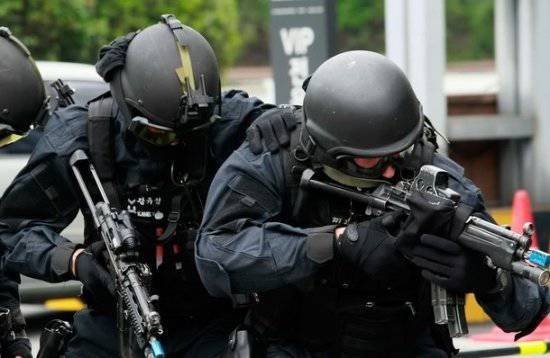
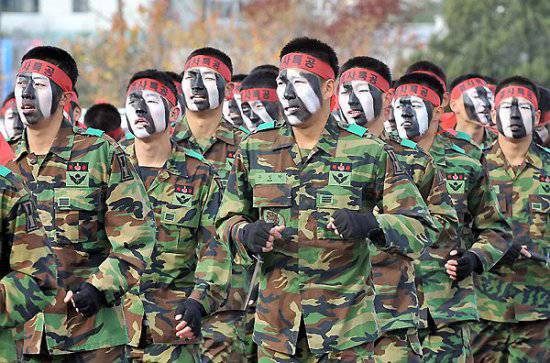
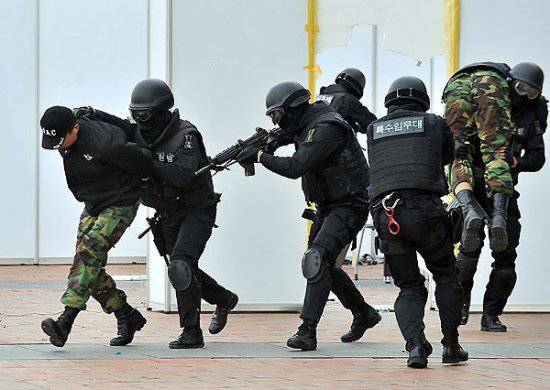
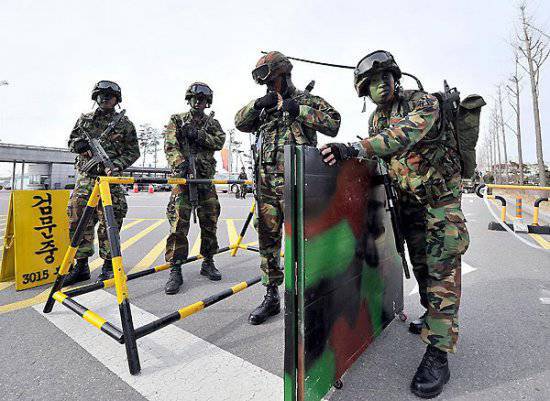
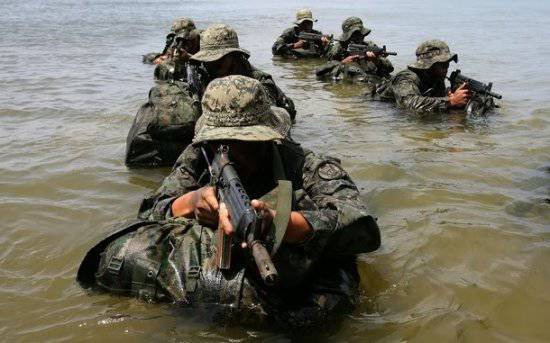
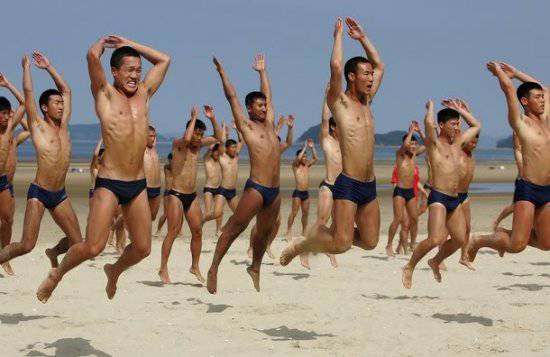
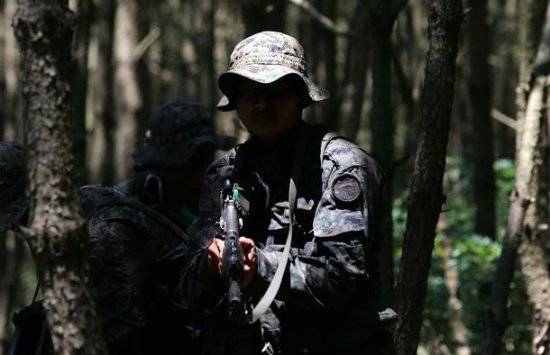
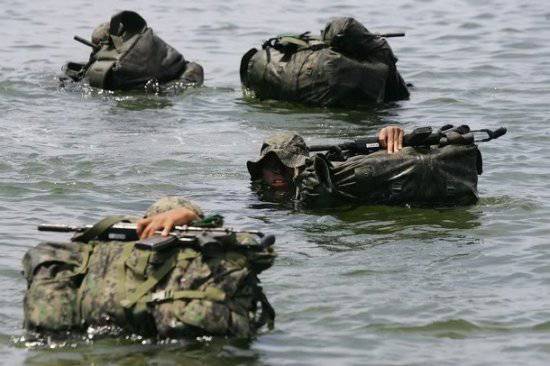
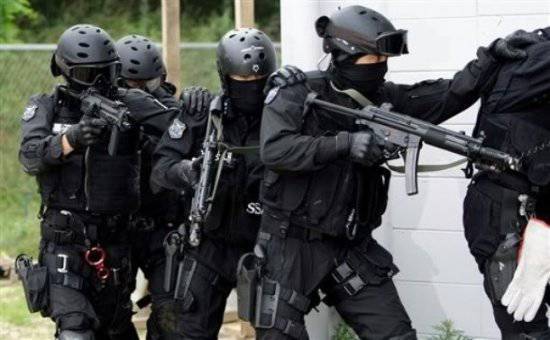
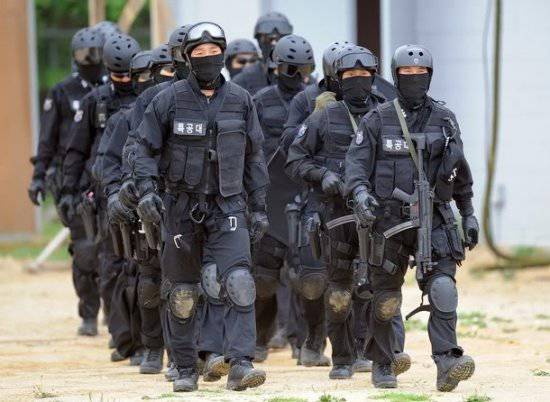
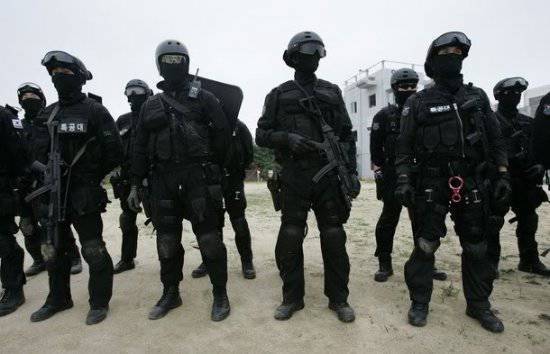
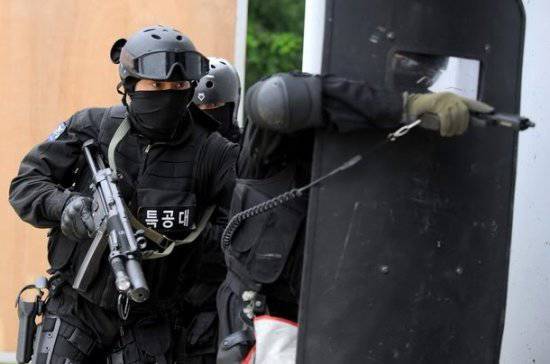
Information